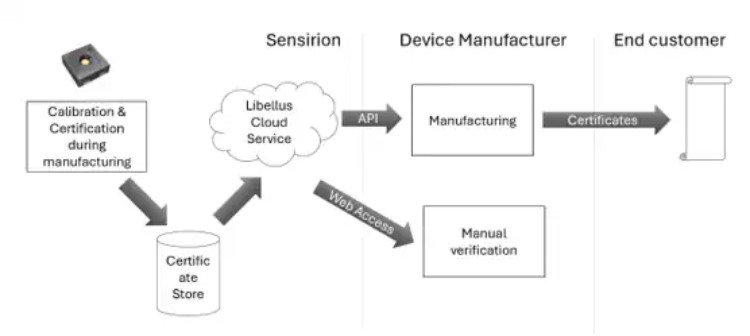When transporting perishable goods such as food or pharmaceuticals, maintaining consistent conditions is critical to guaranteeing that products arrive in perfect condition. For pharmaceuticals, going outside of the allowed temperature range may potentially render the product unusable. For food transport, inappropriate conditions may lead to overripening or spoilage, thus creating food waste. In both cases, the value of the goods transported is lost when conditions are not tracked properly.
Sensor devices used in these applications must offer a high degree of confidence in their performance and are generally required to meet standards defined by organizations such as the World Health Organization (WHO), the National Institute of Standards and Technology (NIST), and the International Standards Organization (ISO). In this blog, we consider a way to reduce the time and effort spent on certification by using pre-certified sensors.
Rethinking Sensor Certification for Product Design
Aside from using components with the right accuracy specification and calibration, devices used in asset tracking applications require certification. The most important certifications are NIST traceability and ISO17025.
Historically, certification was a step done on the device level, as an additional step in the manufacturing process. ISO17025 certification can only be given by an accredited institution. This meant that devices had to be sent to an accredited third-party lab for testing after coming off the assembly line, which added a costly and time-consuming extra step to the overall manufacturing process.
Today, a new approach is simplifying the accreditation process. By using pre-certified sensor components, product designers can remove the post-assembly third-party certification step, enabling product shipment straight from the production line to the end customer. This allows product designers to guarantee accuracy levels of the shipped devices while increasing speed to market.
To achieve this, Sensirion has gone through the process of ISO17025 accreditation. This allows for end-to-end monitoring, simplified manufacturing, and efficient recertification. By adding Sensirion’s certified SHT43 sensor to their designs, designers can meet NIST traceability and ISO17025 compliance without requiring additional changes in their manufacturing process (Figure 1).

Sensor Specification
The Sensirion SHT43 is a state-of-the-art digital humidity and temperature sensor with an I²C interface, offering typical accuracies of 1.8 percent relative humidity and 0.48°C for temperature. With its small size of 1.5mm × 1.5mm × 0.5mm, wide supply voltage range of 1.08V to 3.6V, and low power consumption, the SHT43 is well suited for asset tracking platforms and data logging applications. Reference drivers are available for development setups based on Arduino or Raspberry Pi, along with drivers for the most common microcontroller platforms.
Accessing Certificates via Cloud Services
To access certifications, Sensirion offers a cloud service called Libellus. This service has a web interface to access certificates manually, but more importantly, offers an application programming interface (API). The API can be used during the production process to verify the certification of the specific sensor built into the product, as well as to provide certificates to the end customer of the respective device (Figure 2). The cloud service can be used to obtain documents in portable document format (PDF) and allows direct access to the raw calibration data in JavaScript Object Notation (JSON). This allows device manufacturers to generate certificate documents with all the necessary information on their own (digital) letterhead, ensuring a consistent brand identity.

Accessing Certificates Via the API
Sensor certificates are linked to a sensor’s serial number. The serial number can be read from the sensor via I²C. With the serial number in hand, it is possible to download the calibration data, both as a PDF document and as raw JSON data. The Sensirion API Guide provides a detailed documentation of the Web API.
As an example, here is the cURL command for downloading a sensor certificate as a PDF file for the SHT43 sensor with 123456 as the serial number:
curl --location --request GET \
'https://libellus.sensirion.com/api/SHT43/sensors/123456/certificate?format=application/pdf' \
--header 'Authorization: Token a2b3c4d5token7m8n9o'
Here is a breakdown of the example:
- The product name “SHT43” corresponds to the product used.
- The serial number “123456” is the serial number read via the I²C bus.
- The “Authorization” header token is used to verify user access and is shared with the user upon account creation. If lost, it can be reset under the account profile on the Libellus web interface.
Note that resetting the token will invalidate the older ones; thus, any scripts and processes getting data from Libellus will need to be updated to use the new token.
If the developer prefers to access the raw calibration data, there is a separate endpoint available called “calibration_info” to get this data in JSON, allowing for easy post-processing.
Further Reading
Explore the entire SHT43 product family to see how these pre-certified sensors streamline the design and manufacturing processes.
To learn more about the certification process, differences between NIST and ISO17025, and topics such as recertification or drift estimation, check out Sensirion's in-depth guide on certified smart tracking applications.
Author
 Johannes Winkelmann is Sensirion's Director for Developer Experience, overseeing initiatives to support engineers in evaluating, prototyping, and designing solutions with sensors. With a background in Software Engineering and a decade of experience in developing software for embedded systems, wearables & mobile devices, he has spent the last ten years in the field of developer relations, with a secondary focus on building relationships with ecosystem partners.
Johannes Winkelmann is Sensirion's Director for Developer Experience, overseeing initiatives to support engineers in evaluating, prototyping, and designing solutions with sensors. With a background in Software Engineering and a decade of experience in developing software for embedded systems, wearables & mobile devices, he has spent the last ten years in the field of developer relations, with a secondary focus on building relationships with ecosystem partners.





